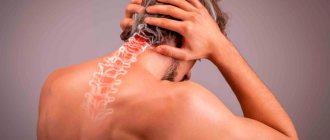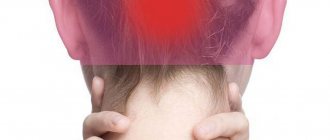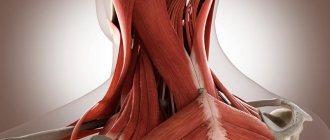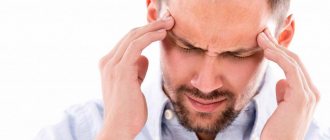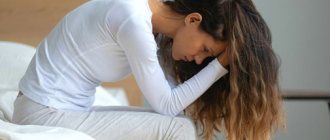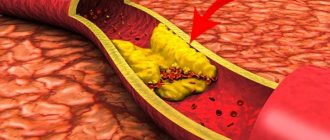Why might the top of your head hurt?
The parietal part of the head can hurt due to many reasons. Sometimes this symptom is present as an independent phenomenon or is accompanied by a number of other signs. Even if there are no other symptoms besides headache, you should not ignore this condition; still seek medical help. Information will be provided by the nature of the pain, its duration, etc.
Does the top of your head hurt? Causes:
- An acute condition when attacks of pain occur suddenly and are not regular. They occur due to injuries, infections, or stress; this condition causes a stroke or rupture of an aneurysm.
- The chronic condition is characterized by regular headaches, which sometimes do not go away even after taking medication. This happens due to a tumor in the brain, constant stress, frequent lack of sleep or due to osteochondrosis.
- If pain occurs in periods, for example once every few days or weeks, and is easily relieved with analgesics, then this may indicate VSD, blood pressure disorders, neuralgia, or female menopause.
- Relapsing syndrome. It manifests itself in hypertension, cluster pain, VSD or a tumor process.
An experienced doctor will be able to guess the cause of vertex pain based on clinical manifestations, but additional research will be needed to clarify the diagnosis.
Headache in the eye and forehead area - causes
It will probably be difficult to find at least one person who has never experienced a sometimes simply unpleasant, and at times unbearable headache. The most common type of this disease is pressure in the front of the skull - the forehead and eyes.
Classification of headaches
There are several types of pain affecting the forehead and eye area:
- Paranasal sinuses – painful sensations in the forehead area, spreading to the cheekbones;
- Cluster pain - this term refers to pain affecting the eyes;
- Tension type - this pain is characterized by squeezing sensations around the entire head;
- Migraine is one of the most painful types, characterized not only by painful sensations, but also often by nausea and vision problems.
What can cause forehead and eye pain?
Most often, a severe headache is not the disease itself, but only its symptom. But there are a great many diseases themselves and other causes that cause pain in the head; let’s look at the main ones:
- Stress is the most common cause of these types of pain. Very often, people who are constantly exposed to emotional stress at work complain of throbbing pain in the temples and forehead.
- Food intoxication - poisoning with low-quality and expired food products can also cause headaches. This also includes the impact on the body of all sorts of harmful substances added to products by unscrupulous manufacturers.
- Poisoning by toxic fumes - toxic substances surround us everywhere and can be a real cause of headaches when staying in close proximity to the source for a long time.
- Hangover syndrome – the consequences of alcohol abuse are accompanied by high blood pressure, dehydration, and as a result – headaches in the forehead and eyes.
- Hormonal background - this point concerns mainly women and the state of their hormones. They may suffer from headaches during pregnancy, menstruation or menopause.
Illness as a cause of headache
All the reasons described above are very general, and anyone can encounter them. Below we will look at what specific disorders of the body can cause a headache in the front part of the skull.
- Almost all diseases from the otolaryngology section (ear, throat, nose) - inflammation in these organs leads to constant headaches;
- Various eye diseases - unfortunately, pain and a feeling of pressure in the eyes can be the cause of any disorders occurring in the organs of vision. Most often, of course, your eyes may hurt due to banal overwork, but if the pain bothers you regularly, then this may be a reason to contact a specialist.
- Benign and malignant tumors - the most serious probable cause of headaches is oncology. Neoplasms can arise in the brain itself - although this disease is rare, it often ends in death due to the fact that the disease is simply in an advanced state.
- Essential hypertension (hypertension) - in this vein, we can talk about both a chronic disease accompanied by a constant increase in blood pressure, and a common predisposition to pressure surges due to weather changes, stress, fatigue, etc. Painful sensations with increased blood pressure are unpredictable and can be concentrated in the temples, forehead, and back of the head, and sometimes cover the entire head.
- Infectious diseases - such as meningitis (pain in the head, eyes and neck is the main symptom of meningitis), malaria, fever, flu, typhoid. The course of the above diseases is accompanied by severe pain in all areas of the head. But do not forget that all these ailments are accompanied by a number of other serious symptoms, so before attributing any disease to yourself, listen carefully to your body.
Author: K.M.N., Academician of the Russian Academy of Medical Sciences M.A. Bobyr
Traumatic brain injuries
Post-traumatic pain in the head can bother a person for the next two months. This condition may be associated with a concussion. The pain in this case is dull and pulling. Sometimes it pulsates.
Additional symptoms of cephalalgia are:
- nausea and weak appetite;
- unstable blood pressure;
- weakness and craving for sleep;
- change of mood.
Ways to get rid of pain:
- bed rest and examination by a doctor;
- analgesics and nootropics;
- sedatives.
Migraine
This disease can be divided into different types:
- Vasomator migraine - pain occurs in the parietal region or on one side, for example, the left upper part of the head hurts. The cause is vascular changes in the brain.
- Neuralgic migraine - pain in the temples and upper part of the head. Causes include weather changes, stress, overexertion and lack of sleep. Sometimes a person complains of nausea, decreased vision and poor coordination of movements.
- Migraine with aura is accompanied by a number of symptoms, which is why this condition is called a syndrome. A person experiences dry mouth, loss of appetite, nausea, dizziness, decreased vision, etc.
Types of throbbing pain in the head in various diseases
If a person focuses on his sensations in the back of his head, understands how long the pulsation lasts and what its frequency is, he can himself determine the presence of a particular disease.
- If the pulsation begins in the morning and there is a feeling of heaviness in the head and an increased heart rate, this is a sign of pressure changes, often hypertension. In some cases, along with these signs, pain in the temples is observed.
- Regular pulsation in the temples of the head indicates the presence of VSD. Often dizziness and nausea are added to the pulsation.
- A slight throbbing pain in the back of the head and a feeling that the pain is radiating to the ear or jaw is the result of hypothermia or the onset of a cold or infection.
- Pulsation in the back of the head and temporal part, as well as in the temples, and this pain is accompanied by weakness throughout the body, perhaps blood vessels are pinched somewhere or a spasm has occurred.
- Symptoms of cervical migraine are sudden attacks of pulsation, while flashes appear in the eyes.
- With cervical osteochondrosis, a strong pulsation occurs in the back of the head, in addition, it becomes dark in the eyes and noise in the ears appears.
- Pain in the back of the head, which spreads to the right side of the head, in the temple area, indicates a strong jump in intracranial pressure, migraine or vasospasm.
Osteochondrosis
If the upper part of the spinal column is affected, then blood circulation is disrupted, first in the cervical region, and then in the brain. Due to this, a radicular pathology occurs - neuralgia, when the upper part of the head hurts severely. The pain can radiate to the temples, back of the head, cheekbones, shoulders and even to the shoulder blades. As accompanying symptoms, the following signs of cervical osteochondrosis appear:
- Loss of sensation in the upper limbs and occiput.
- Frequent dizziness.
- Double vision.
- Weakness of muscle tone in the cervical spine.
- The head and upper part of the skull may hurt.
Treatment is expected to be comprehensive. First of all, the manifestations of osteochondrosis, including headaches, are eliminated.
Pain in the neck and occipital part of the head. Causes and their treatment
Meanwhile, the source of headaches or back pain can be serious illnesses. The most common today is osteochondrosis, but other diseases of the cervicothoracic back can also occur.
The neck is a very sensitive and delicate part of the human body. This rather small area contains all the clusters important for human life. These include large veins and aortas, blood vessels and nerve clusters, lymph nodes, etc. It is not surprising that problems in this part of the spine lead to deterioration of well-being, decreased ability to work, and disruption of the functioning of the entire body.
Symptoms of osteochondrosis in the cervical area of the back are often similar to the symptoms of a disease such as vertebral artery syndrome. Then the sensations of aching pain in the back of the head and neck intensify, accompanied by muscle strain or increased tone, inflammatory processes, circulatory disorders, and swelling.
In the early stages of the disease, pain may appear when you are in an uncomfortable position for a long time, with prolonged tension of the neck muscles, sudden turns or tilts of the neck. Pain can also be caused by local hypothermia resulting from prolonged exposure to an air conditioner or when traveling in a vehicle with open windows, etc.
The localization of pain in the cervical spine can be either on the left side or on the right, or can be immediately felt on both sides. In this case, the intensity of pain can fluctuate from severe acute attacks to aching chronic, barely noticeable.
The root cause of pain in the cervical spine:
- osteochondrosis of the cervical spine, pathological damage to the ligaments or muscles of the cervical corset;
- traumatic injuries, tumors (also oncological);
- muscle spasms that occur after sudden movements or prolonged static physical activity;
- viral infections, arthritis (for example, rheumatoid);
- meningitis, retropharyngeal abscess;
- hypothermia and long-term stay in an uncomfortable position.
The root cause of pain in the back of the head:
- diseases of the cervical vertebrae;
- cervical spondylosis;
- violation of the condition of the muscles of the cervical corset, as a result of incorrect posture, hypothermia, nervous strain, stress;
- muscle spasms of physical or nervous origin;
- overstrain of physical or mental origin;
- neuralgia of the occipital nerve endings (in this case, pain can spread along the back, radiate to the upper limbs, as well as to the lower jaw, ears);
- arterial hypertension;
- muscle fatigue caused by improper physical activity;
- migraine of the cervical region (sensation of burning pain in the temporal parts of the skull, occipital part, in the superciliary arches).
Diagnosing pain at home
It is extremely difficult to diagnose at home, especially if it is not attempted by a specialist in the relevant field. There are often cases when hypertension (high blood pressure) is considered the cause of headaches, without suspecting that pain can occur due to diseases of the spine. In this case, the prescribed treatment will not bring any results or will have the opposite effect.
In order to establish an accurate diagnosis, and accordingly the root cause of pain in the back of the head or cervical region, various research methods are used. This includes radiography, magnetic resonance imaging, computed tomography, etc. Based on the results of the images, the doctor will make the correct diagnosis and prescribe a specific treatment. Accordingly, it is simply impossible to carry out this diagnosis at home, and do not even try to self-medicate.
Treatment
The first step in treating pain in the neck and back of the head is pain relief. For these purposes, painkillers are used, sometimes in combination with anti-inflammatory or anti-edema agents. After the patient feels a little better, the process of diagnosing diseases that cause pain begins.
Having established an accurate diagnosis, the doctor prescribes a course of treatment. Moreover, for each patient it will be individual, taking into account all the structural features of the body, state of health and symptoms and stages of the disease. For different detected diseases, different therapeutic treatments will be prescribed, but the principles and methods of treatment in most cases will be similar.
After drug treatment or in parallel with it, physiotherapy, a course of special physical therapy, all types of general massages, manual therapy and osteopathy are usually prescribed. For almost all diseases, it is recommended to start swimming.
treatment of the spine, including the cervical spine, is a very long and complex process, even more complicated due to the structural features of the neck. After all, for the cervical area it is almost impossible to organize complete rest, which is necessary for treatment.
If pain syndromes accompany the patient for a long time and seriously limit his motor activity, or the disease begins to affect the functioning of internal organs and other body systems, surgical intervention is permissible.
But remember, surgery is used only in extreme cases or in severe complications. For the most part, it is possible to cure ailments that cause pain in the back of the head or neck using the conservative methods listed above. Author: K.M.N., Academician of the Russian Academy of Medical Sciences M.A. Bobyr
Tumors
Often the culprits of headaches are benign or malignant tumors located in the brain. These circumstances cannot be eliminated with pills or improvised means of treatment; serious therapy will be required under the supervision of the attending physician.
The pain in the presence of a tumor will be constant and intense. Painkillers do not help in this case. The pain is worse in the morning or after physical activity.
Among other things, other symptoms are present:
- Nausea, often turning into vomiting.
- Decreased vision or hearing.
- Poor motor coordination.
- Memory loss.
- Mood swings.
- Drowsiness and lethargy.
Symptoms that may accompany a headache on the top of the head
Often, headaches are accompanied by additional symptoms that may indicate a specific disease. Some of them can pose a significant health threat, so you should seek medical help immediately. Additional symptoms of headache may include:
- Sudden vision loss.
- Irregularity of blood pressure.
- The headache does not stop even after taking painkillers.
- Increased body temperature due to headaches.
- Dry throat and nausea accompanying pain in the upper part of the head.
Causes of headaches in children
Doctors divide headaches into primary and secondary . Primary ones are independent diseases. In childhood, these are mainly migraines and tension headaches. In secondary cases (cephalgia) it is only one of the symptoms of another disease. There are more than 150 known diseases that are accompanied by headache complaints.
The cause of headaches is always a violation of the blood supply to the brain. But why this happens - there can be quite a few possible answers to this question. For example:
- Imperfection of the body's autonomic system,
- Beginning colds (prodrome),
- The presence of any serious disease: kidney disease, endocrine disorder, anemia, rheumatism and others;
- Toothache, which provokes headache;
- Consequences of head injury;
- Excessive nervous tension associated with stress, long hours of work, conflict, serious experience, etc.
- Influence of the external environment: prolonged stay in a stuffy room, increased solar radiation, prolonged exposure to the sun, etc.
Headaches can occur as a reaction to changes in the environment or in the body (reactive), poor lifestyle: when a child has too little or too much sleep, spends too much time in front of the computer or TV screen, is not physically active, or eats incorrectly. After the initial examination of the patient with complaints of headaches, the pediatrician will refer him for the necessary consultations and examinations, depending on the identified disorders. In most cases, children with complaints of headaches are observed and registered with a neurologist.
Examination methods
You should consult a specialist if you constantly have a headache in the upper part of your head. Even the most qualified doctor will not be able to determine the cause of the pain on his own, so the patient is sent for examination.
Fortunately, nowadays, thanks to innovations in the field of medicine, identifying the cause of this condition is not particularly difficult. The most informative method is MRI. Using this device, the doctor can examine the brain of a sick person in detail and determine the pathological condition.
But if there is a circulatory disorder, a CT scan will have to be performed. The vascular condition is determined by the MRA method (magnetic resonance angiography).
To detect the presence of infection, it is necessary to take a blood test. If, in addition to the pain in the upper part of the head, your vision has also decreased, you will need to consult an ophthalmologist. He will examine the fundus of the eye and determine possible abnormalities.
Diagnostic measures for pain in the vertex
Painful sensations may be a manifestation of an abnormal process in the brain or bones of the skull and a secondary sign of a lesion of a different origin. To determine the specific source of the disorder, you need to undergo a series of clinical and instrumental tests. When visiting a doctor, the patient undergoes a survey and examination to determine the nature of the pain, the time of its onset, the cases in which it occurred, and the duration of the attacks. The doctor examines the condition of the skin of the face and scalp and neck. This helps identify signs of damage to the skull or cervical spine.
Dynamic monitoring of pressure surges over 24 hours is carried out by Holter blood pressure examination. By studying the fundus, visual fields and intraocular pressure, it is possible to understand the indirect causes leading to increased intracranial pressure. Additionally, the patient is prescribed a number of instrumental diagnostics:
- X-ray screening of the skull, which helps to identify bone fractures or the consequences of surgical interventions as a result of injury;
- X-ray of the cervical spine shows the development of osteochondrosis and other similar anomalies;
- MRI or CT scan of the brain helps determine the presence of strokes and their nature, the severity of TBI, the presence of hemorrhage or the formation of intracranial hematomas, tumors and abscesses;
- Angiographic examination of blood vessels identifies neoplasms, aneurysms and vascular malformations.
Additionally, the patient must donate blood for general and biochemical analysis so that the doctor can study the amount of hemoglobin and leukocytes. If their number changes, the patient is considered to have inflammation or anemia. In the second case, the results show the level of glucose, urea and liver tests.
Principles of treatment
If the head and upper part of the skull hurt, treatment will be prescribed only after a complete examination of the patient. This must be done, especially if the pain bothers you frequently or regularly.
It is not prohibited to take painkillers on your own, but if the headache is a one-time headache, with repeated discomfort in the head, the pills can even be harmful. If the problem is minor, you can use the “Star” balm. It will temporarily relieve headaches.
When purchasing any medicine at a pharmacy, first read the instructions for it. This is especially true for children. Remember that many medications may be contraindicated for young children.
How to treat headaches?
This treatment is provided for headaches not associated with serious pathologies:
- Analgesics. They will help to get rid of pain for a while, but will not eradicate the cause. It is also worth remembering that the pills can be addictive, and each time the pain will intensify, and you will need even more medicine.
- For moderate pain, you should not take pills; just take a walk in the fresh air and apply an alternating compress - hot and cold. Usually these measures help if your head hurts from overwork or nervous tension. You should not smoke or drink alcohol at this time, they will only worsen the situation.
- Acupuncture or acupressure can also help with occasional headaches. It is advisable to contact a specialist who knows which points to influence.
- Head massage helps with minor pain and migraines. The person relaxes and the discomfort goes away.
- Music therapy. It is better to include classical or ethnic music. But not all types of headaches can tolerate extraneous noise; for example, if you have a migraine, it is better to abandon this idea.
- Introduction of the drug "Botox". If you administer this remedy intramuscularly, it will create a lasting result that will eliminate tension and spasms in the head.
All these methods can be effective if the pain occurs as a result of stress, tension, overwork, etc.
29.07.2019
“Hoop” of tension, or Why does your head hurt?
It is believed that a headache can have a thousand causes and, of course, a doctor must differentiate it. If you experience regular, severe attacks, you should definitely contact a specialist to make a diagnosis and prescribe treatment.
We talked about why headaches occur, in which cases you can just lie down or take a pill, and when this is a reason to worry and see a doctor - we talked about this with the head of the neurological department of the Regional Vascular Center of the First City Hospital, Maria Kolygina.
Migraine loves the dark
– Maria Rufinovna, what are the most common causes of headaches?
– One of the most common is the so-called tension headache. We all live in stressful times, we take on streams of negative information, and constantly solve some problems. And if there are many problems, tension from the cerebral cortex is transferred to the muscles of the body, which experience chronic spasm. As a result, the body does not relax at all. This is when a tension headache occurs.
Patients describe their sensations something like this: their head is heavy, as if they are wearing a hoop or helmet, their neck muscles ache. Some complain of pain in the eyes, especially when moving the eyeballs, and blurred vision.
Of course, this condition is treatable. But the main thing here is to learn to relax. When a person comes home tired from work and experiences tension in the muscles of the neck and shoulder girdle, he needs to take a contrast shower, massage his shoulders, lie down... The best prevention of tension headaches is regular adequate physical activity - the gym, swimming, Nordic walking, just walking in the fresh air . Everyone chooses for themselves what they like to do.
Another common type of harmless headache is venous. It is a consequence of the congenital structural features of the veins of the head. In a person, the outflow of blood through the saphenous veins is impaired, resulting in stagnation, especially at night. He wakes up with a headache, a pasty face, and puffiness under the eyes. To bring yourself back to normal, you need to drink coffee or freshly brewed tea, walk for at least half an hour and take a contrast shower. To treat such pain, there are special drugs that tone the veins of the brain and alleviate the condition. Well, prevention again is physical activity.
These two types of headaches are harmless and easy to treat on your own.
– Where does migraine come from?
– It is associated with the release of vasoactive substances into the blood, which first causes a sharp spasm of the artery, and then its relaxation, the vascular tone of the artery is disturbed - a migraine attack occurs.
Such attacks are characterized by severe headaches, often one-sided. To make it easier to move, the person asks to turn off the lights and close the windows with curtains. It is easier for him to be in the dark and in silence. Because any sound or bright light is an irritant that provokes a new attack of headache. It is believed that migraines affect women more often, this is due to hormonal levels.
There are two types of migraine: with and without aura. An aura is a change in state that occurs before a painful attack. Someone’s field of vision “loses” (the so-called visual aura); someone begins to feel “goosebumps” on the body, numbness of the lips, tongue. These sensations pass quickly, literally in five to ten minutes, and then a severe headache develops. A migraine attack is often triggered by certain foods, for example, blue cheese, red wine, chocolate, and smoked meats.
There are special medications to relieve migraines, and patients use them successfully. If a migraine attack lasts for a day or more, it is better to call an ambulance.
Stroke doesn't hurt
– What headaches are considered the most dangerous?
– Pain associated with some kind of catastrophe in the brain, in particular, with hemorrhage. This can happen with a congenital aneurysm of the cerebral vessels, the existence of which a person sometimes does not even know. He lives a normal life, is active, moves a lot, but one day this aneurysm bursts, and a severe headache develops with photophobia, nausea, vomiting, and even loss of consciousness is possible. Here you need to immediately call an ambulance.
Sometimes a headache can be one of the symptoms of a brain tumor; these suspicions can be confirmed or refuted using magnetic resonance imaging.
Headache with meningitis is dangerous. This is an inflammatory disease of the membranes of the brain, most often it is associated with infectious factors - previous acute respiratory viral infections, ear diseases, sinusitis and others. The patient, in addition to headache, photophobia, nausea and vomiting, experiences an increase in temperature. The diagnosis of meningitis is confirmed only by puncture; it is not visible on either CT or MRI. The same symptoms occur with tick-borne encephalitis after a tick bite. If this happens, the tick must be saved and submitted for examination, and the person must go to an infectious diseases hospital.
– When is a headache a prerequisite for a stroke?
– There is no direct connection here. Moreover, one of the main dangers of a stroke is that it doesn’t hurt. For example, when a person develops a myocardial infarction, blood circulation in the heart muscle is disrupted and severe chest pain occurs. And in most cases, people get scared and immediately call an ambulance, they are taken to cardiology.
In case of a stroke, an arm or leg may fail, speech may be impaired, and the field of vision may “fall out.” And it happens that a person remains at home for several more days, waiting for the illness to go away on its own. In fact, this is a manifestation of a terrible disease.
Therefore, I would like to once again remind you of the symptoms of a stroke: speech impairment, facial distortion, weakness in an arm or leg, impaired gait and coordination of movement.
Now there are modern methods of treating stroke, and the sooner a person arrives at the hospital, the greater the chance of using them. In particular, introduce a special drug into the blood - a thrombolytic, which quickly dissolves blood clots in the vessels, but it can only be used for the first four hours after the onset of the disease. If everything is done on time, the stroke clinic goes away right before our eyes. But even if some symptoms remain, it is much easier to rehabilitate such a patient.
– What leads to stroke, what are the risk factors?
– All risk factors for stroke are divided into two large groups. These are unmodified, that is, those that a person cannot influence - age, gender, race, heredity. And modified ones, which we can and should influence. First of all, arterial hypertension. If a patient is diagnosed with hypertension, he must take high blood pressure pills for life - every day, regularly. This is the only way to keep blood pressure at a normal level, not higher than 140/90.
Unfortunately, there are cases when a person takes medications for a month or two - the condition improves, and he cancels them himself. Three days later - hypertensive crisis and stroke. During withdrawal symptoms, blood pressure usually rises even higher than it was before treatment.
Risk factors include high cholesterol. Depending on its level and the condition of the blood vessels, either special drugs are prescribed - statins, or you can limit yourself to following the so-called Mediterranean diet. Its rules are simple: do not eat pork or lamb, but only lean white meat - rabbit, chicken, turkey. Replace fried foods with baked or boiled ones. Actively include fish in your diet: salmon, herring, mackerel, horse mackerel, and cod are considered the healthiest. And of course, more vegetables, fruits, leafy greens, and our northern berries. Physical activity prevents the development of atherosclerosis. A person should walk five to six kilometers a day.
– What risk are people with low blood pressure exposed to?
– It is less dangerous in terms of the development of strokes, but these people are prone to fainting, especially in stuffy rooms and transport. They are encouraged to actively engage in physical activity and spend more time outdoors. And be sure to have a hearty breakfast in the morning, drink freshly brewed tea or coffee to normalize vascular tone.
Think about your lifestyle
– Maria Rufinovna, stroke is considered an age-related disease. Why does it happen to young people?
– In general, a stroke is the result of those diseases that a person has accumulated during his life: atherosclerosis, hypertension, heart disease. In our department, 75–78 percent of patients with strokes are over 60 years of age. But strokes occur at an earlier age: 20–40 years. It cannot be said that stroke is getting younger; the numbers are stable from year to year.
Most often, a stroke in young people is a disorder in the blood coagulation system, caused by genetic disorders. If a person’s closest relatives suffered from a stroke or heart attack early enough, at the age of 45–55, then already at thirty he needs to think about his lifestyle (quit smoking, alcohol abuse), control blood pressure, donate blood for sugar and cholesterol, and do an ultrasound examination neck vessels and MRI of the brain.
– How much does your well-being depend on your daily routine?
– Everything depends on the daily routine, not only health, but also performance, physical and mental activity. Our physiology is designed so that the process of falling asleep occurs from 22 to 23 hours. During this period, human biorhythms work towards falling asleep. If you sit in front of the TV or at the computer until twelve, until one in the morning, it will be difficult to “switch off.” Ultimately, the person will fall asleep, but the sleep will be superficial, and in the morning he will get up broken. The ideal option for health is to fall asleep before 11 pm and get up between six and seven in the morning. The female body requires one to two hours more sleep than the male body. Then the body rests and truly recovers, which means the person will be healthier. The daily routine includes not only adequate sleep, but also proper distribution of workloads, balanced nutrition and physical activity.
A person’s health largely depends on their emotional mood - communication with pleasant people, favorite hobbies, caring for pets, everyone finds their own...
Natalia SENCHUKOVA
Source: city newspaper “Arkhangelsk - City of Military Glory”
https://xn--80aec1d.xn--p1ai/archives/20189
Drug therapy
To know which medications help with pain in the crown, you should familiarize yourself with this list:
- "Citramon", "Askofen" are indicated if a decrease in pressure is observed.
- "Farmadipine", "Captopril" - these drugs are indicated for high blood pressure.
- Vitamin and mineral complexes are indicated for migraines.
- "Sedalgin" is prescribed for cluster pain.
- “Spazmalgon”, “Ibuprofen”, “Nurofen” are painkillers that are recommended to be taken for paroxysmal pain in the head. After this, the patient should lie down.
- Walking in the fresh air is recommended for neuroses, depression or after stress. Such people are often prescribed antidepressants, psychotherapy courses and a relaxing massage.
It is recommended to take all medications after consulting a doctor.
Traditional therapy for headache relief
The following folk recipes have proven themselves:
- Application of cabbage leaf. This method has been tested for years. The sheet is applied to the top of the head and left there for 30 minutes.
- Place your feet in a basin of hot water; for greater effectiveness, wrap your head with a cloth soaked in cold water.
- If the upper part of your head hurts, prepare soothing teas based on herbs such as mint, valerian, and marjoram.
- Aromatherapy will be useful for migraines; the aromas of herbs such as sage, mint, marjoram or lavender can temporarily relieve headaches.
- Try wearing amber beads or a bracelet, they help with headaches.
- Oddly enough, by applying a mask of fresh cucumber to your face, you will also help yourself get rid of headaches.
- Applying a cold compress to the head reduces soreness.
Prevention
To prevent pain in the upper part of the head, the following preventive measures are necessary:
- No need to sit in one place, be active, exercise and walk.
- Reduce your consumption of coffee and alcohol, they contribute to increased blood pressure; the healthiest and safest drink is regular drinking water.
- Pain will not bother you if a person includes foods rich in vitamin B2 in his diet. It is found in nuts, spinach, eggs and broccoli.
- Food must be balanced; if some foods are missing, then there will be a shortage of necessary microelements. It is also necessary to avoid foods that are too fatty, fried, spicy and salty. The diet should always include fresh fruits and vegetables, cereals and dairy products.
- Lack of sleep can cause headaches, so you need to get enough sleep, which is an average of 7-8 hours of sleep a night. Before going to bed, ventilate the room; fresh air helps you fall asleep faster.
- Don't allow stress in your life, don't get overtired. Remember about proper rest, which perfectly prepares you for the upcoming work. Often, pain in the top of the head occurs due to overexertion; after proper rest, it usually goes away.
- You should give up bad habits.
When the upper part of the head hurts, interest in life disappears. I would like to do everything possible and impossible to eliminate the discomfort. Early diagnosis will help begin timely therapy, so do not delay your visit to the doctor.


